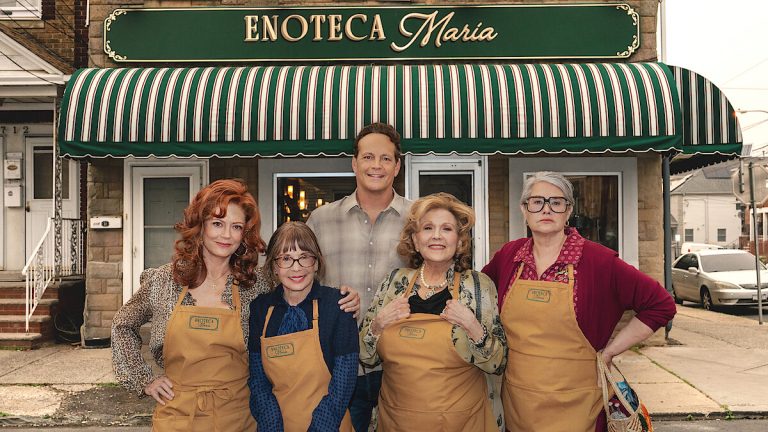Nonnas on Netflix: A Love Letter Baked in Sauce, Grief, and Garlic.
Everyone has that one childhood dish — a flavor-memory that never quite tastes the same when recreated. In Nonnas, Netflix’s latest heartwarmer directed by Stephen Chbosky (The Perks of Being a Wallflower), that gap between memory and reality becomes the emotional core of a story that’s as much about grief as it is about garlic.
Loosely based on the real-life story of Staten Island’s Enoteca Maria — a restaurant run by a rotating cast of real Italian grandmothers — Nonnas follows Joe Scaravella (played by Vince Vaughn), a grieving son who decides to honor his late mother by opening a kitchen filled with women who cook the way she did: from the heart, with no recipes, just instinct and love.
The Setup: From Wake to Wine Sauce
The film opens with a dizzying, nostalgic montage of 1980s Brooklyn — fresh cannoli being piped, tiramisu dusted, red-and-green cookies stacked like edible childhood. It’s a sensory wallop. We then time-jump to Joe at his mother’s wake, surrounded by sympathy casseroles, haunted by the one dish no one can replicate: his mom’s sauce.
In his grief, Joe impulsively opens a restaurant. But instead of chefs, he recruits nonnas — starting with his mother’s best friend (Lorraine Bracco), and soon adding women played by Susan Sarandon, Brenda Vaccaro, and Talia Shire. It’s a kitchen full of personality, profanity, and perfectly simmered arguments.
:max_bytes(150000):strip_icc()/First-Look-at-Netflixs-Nonnas-FT-BLOG0425-01-d0b19f35733f4c40a28b7593d9a3f575.jpg)
The Power of Food, Without the Platitudes
This isn’t your typical “culinary redemption” flick. Nonnas doesn't pretend food fixes everything. The cooking scenes — shot with remarkable warmth by Florian Ballhaus — are textured with ritual, not revelation. There's no magic pie that makes everyone cry. Instead, the women cook because that’s what they do. It’s how they endure.
Screenwriter Liz Maccie, drawing from her own Italian-American upbringing, avoids sentimentality by grounding emotion in detail. The clang of vintage Tupperware. The plastic-covered dining chairs. The sacred lasagna that takes three days to make. It’s not just food porn — it’s food as oral history.
What’s New: A Surprise Streaming Hit
Since its May 9 debut, Nonnas has exploded on Netflix. In the last 24 hours, the streamer confirmed the film topped the platform’s global Top 10 list, with over 15 million views across 71 countries. That momentum, insiders say, could greenlight a limited series spinoff centered on the restaurant’s newer nonnas from different cultures — including rumored interest from Korean, Jamaican, and Syrian communities in New York.
Critics expected a low-key Mother’s Day release. What they got was an intergenerational sleeper hit.
Aging Women, Finally Centered
Where Nonnas truly shines is in giving older women the spotlight — not as jokes, but as full, complex characters. A limoncello-fueled scene where the nonnas share regrets is raw and funny, not twee. There's no "oops-we-ate-pot-brownies" gag here. These women are sharp, salty, and deeply human.
It’s also a quiet rebuke to the streaming trend of wasting legends like Sally Field and Kathy Bates in throwaway roles. Nonnas lets Bracco, Sarandon, Shire, and Vaccaro cook — literally and figuratively.
At Its Core: A Family Love Letter
Perhaps the most affecting thing about Nonnas is how personal it feels — and is. Maccie wrote the script as a tribute to her mother and aunt. Chbosky, her husband, directed it as a tribute to her. Their kids will forever remember the story of how “Mom’s Christmas Eve lasagna” became a movie.
And that’s the film’s quiet magic. It doesn’t ask you to believe food heals everything. It only asks you to remember that the best meals — and the best moments — were made by hands you loved.









